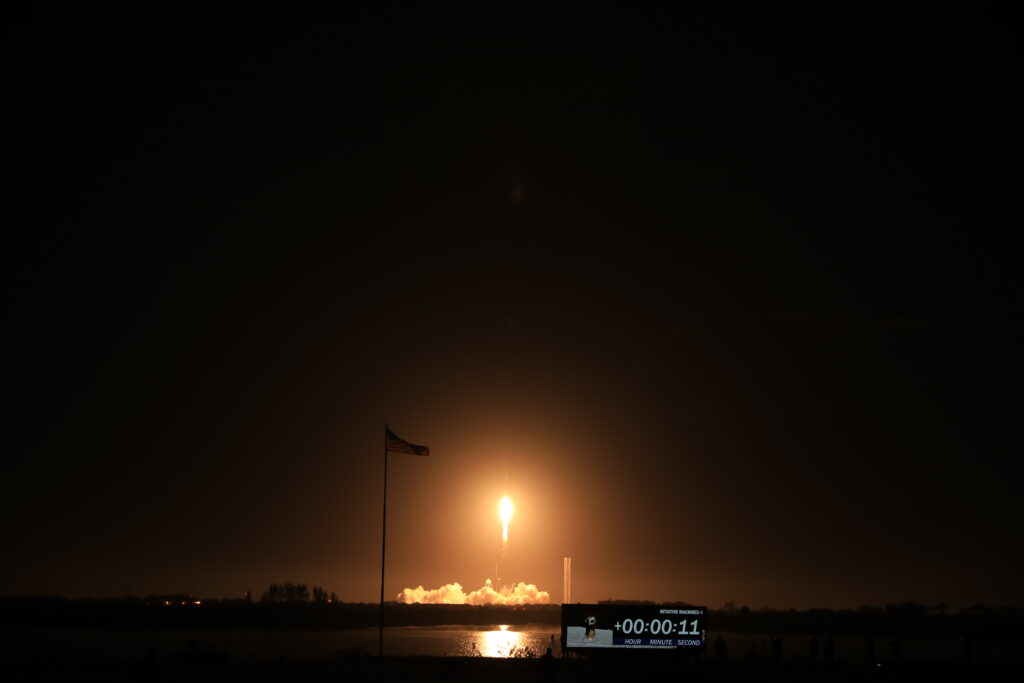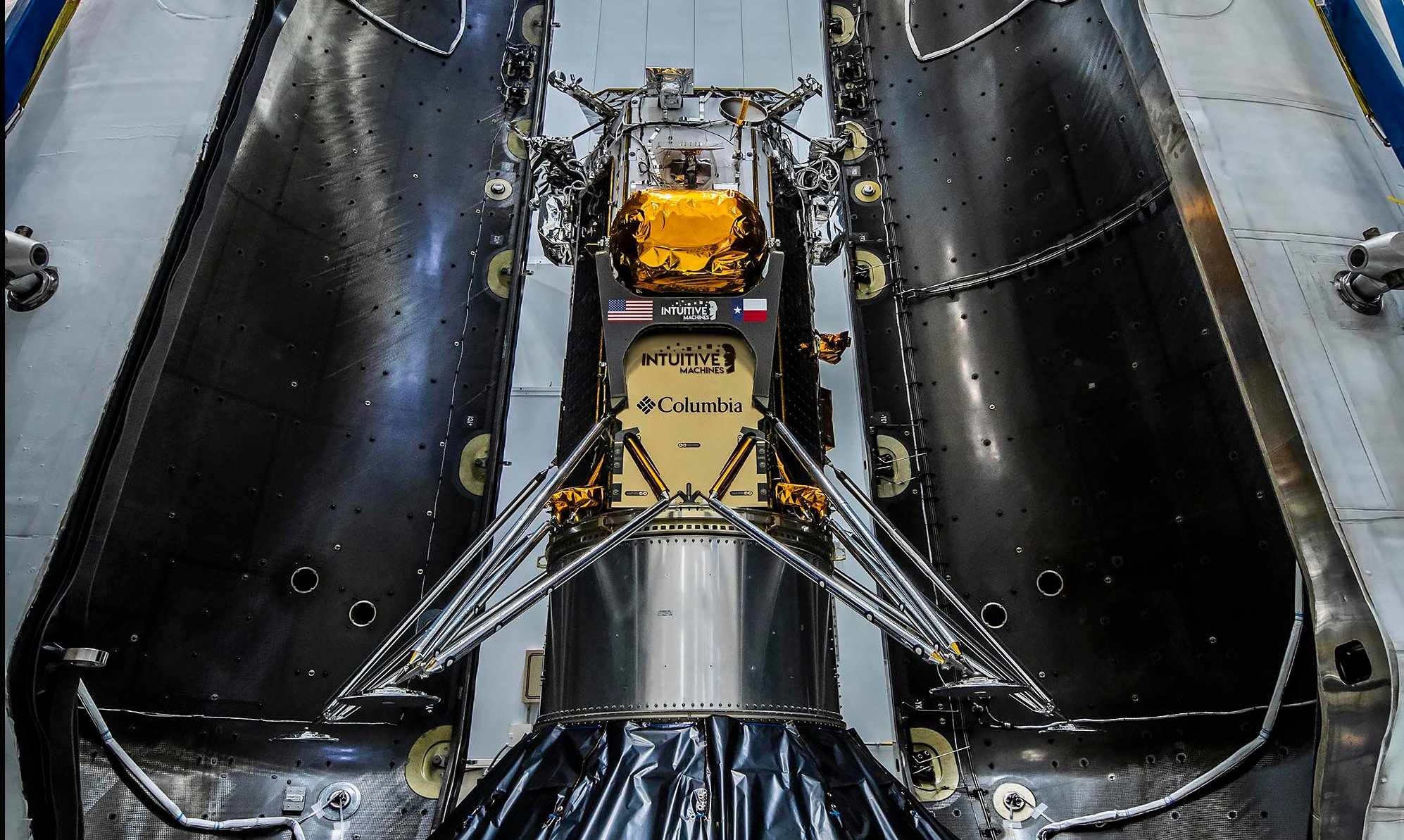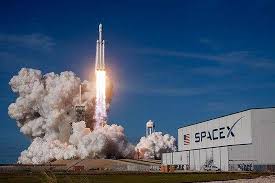
Intuitive Machines’ IM-1 spacecraft is en-route to the Moon tonight, following a spectacular 1:05 a.m. EST Thursday launch atop a SpaceX Falcon 9 booster from historic Pad 39A at Florida’s Kennedy Space Center (KSC). The ambitious mission, which carries a group of scientific research instruments from NASA and academia, together with the first piece of sculptural artwork destined for another world, is flying under the Commercial Lunar Payload Services (CLPS) contract and, if successful, will become the first U.S. spacecraft to soft-land on the surface of our closest celestial neighbor since Apollo 17 in December 1972.
Originally scheduled to launch at 12:57 a.m. EST Wednesday, SpaceX teams elected to postpone to Thursday’s backup opportunity, citing “off-nominal methane temperatures” as they prepared to load IM-1’s Nova-C lunar lander (named “Odysseus” in honor of the ancient hero of the Trojan War) with liquid methane propellant. That resulted in two other Falcon 9 missions on the East and West Coasts—the first carrying the U.S. Space Force’s highly classified USSF-124 payload from storied Space Launch Complex (SLC)-40 at Cape Canaveral Space Force Station, Fla., the second a batch of 23 Starlink low-orbiting internet communications satellites from SLC-4E at Vandenberg Space Force Base, Calif.—leapfrogging IM-1, targeting their own launches on Wednesday afternoon.
The result could have produced a pair of launches a record-setting 120 minutes apart, creating a pair of lovers’ candles on both U.S. seaboards for Valentine’s Day, but it was not to be. USSF-124 took flight right on time at 5:30 p.m. EST and emplaced six payloads into low-Earth orbit: two Hypersonic and Ballistic Tracking Space Sensor (HBTSS) satellites for the Missile Defense Agency (MDA) and the final four Tranche 0 Transport and Tracking Layer (TTL) satellites for the Space Development Agency (SDA).
All six payloads “were safely delivered to their intended orbit”, noted Space Systems Command (SSC) in an update shortly after last night’s USSF-124 launch. “We’re proud to support both the MDA and the SDA with this co-manifested National Security Space Launch,” said Col. Jim Horne, senior materiel leader for SSC’s Launch Execution Delta. “We’ve worked side-by-side with our launch service provider and space vehicle partners to achieve the mission on-time and with precision.”
USSF-124 rose to orbit atop B1078, a Falcon 9 booster introduced to the fleet last March and making her seventh flight. “We’re reaping the benefits of this innovation with every launch,” said Dr. Walt Lauderdale, SSC’s Assured Access to Space (AATS) mission director. “As we move forward together with SpaceX, we’re methodically expanding reuse to leverage the benefits for the USSF and our space vehicle teammates.
“The mission team was able to add the Tranche 0 satellites to USSF-124 in under 30 days, less than six months from the then-scheduled launch date,” Dr. Lauderdale continued. “This unprecedented responsiveness is a needed capability for the Space Force to confront today’s threat environment.”
Attention then turned to Vandenberg, where the once-flown B1082 booster stood primed at SLC-4E with a payload of 22 Starlink internet communications satellites weighing in at 38,800 pounds (17,600 kilograms). A liftoff at the opening of this mission’s “launch window” at 4:30 p.m. PST (7:30 p.m. EST) would have produced a new empirical record of exactly two hours between pairs of Falcon 9 missions, eclipsing SpaceX’s prior personal best of two hours and 54 minutes set late last December.
 Intuitive Machines’ IM-1 Odysseus lander is readied for encapsulation inside the Falcon 9 payload fairing for launch. Photo Credit: SpaceX
Intuitive Machines’ IM-1 Odysseus lander is readied for encapsulation inside the Falcon 9 payload fairing for launch. Photo Credit: SpaceXHowever, shortly after the USSF-124 launch, SpaceX noted on its website that it was tracking a T-0 later in the evening, aiming for 5:34 p.m. PST (8:34 p.m. EST), only 20 minutes shy of the closure of Wednesday’s “window”. Ultimately, the mission was stood down and realigned for a four-hour backup window that opens at 1:34 p.m. PST and closes at 5:33 p.m. PST Thursday.
As this apparent “game” of rocket musical chairs played out, attention returned to the Space Coast and Intuitive Machines’ IM-1 mission. As previously detailed by AmericaSpace, IM-1’s Nova-C Odysseus lander aims to touch down on 22 February near Malapert-A, a 15-mile-wide (24-kilometer) “satellite crater” of the three-times-bigger Malapert impact basin near the Moon’s South Pole at 80.4 degrees South lunar latitude.
It will bring to the lunar surface a dozen payloads from NASA, the International Lunar Observatory (ILO), the University of Colorado at Boulder, Embry-Riddle Aeronautical University, Louisiana State University and others for the first U.S. soft-landing on our closest celestial neighbor since Apollo 17 in December 1972. IM-1’s chance at achieving that goal has been rendered newly possible following the disappointing loss of Astrobotic’s Peregrine lander, which suffered a catastrophic propellant leak shortly after launch in January and—though it attained lunar distance—was unable to make it to the surface.
IM-1’s suite of payloads includes six instruments from NASA: an array of laser retroreflectors and a sophisticated navigational lidar for precise ranging, a lighthouse-like navigation demonstrator, an investigation into how well future Moon-based radio observatories might function on the Moon, an experiment to explore the response of lunar regolith to rocket exhaust and an innovative propellant mass gauge.
Also aboard is Embry-Riddle University’s EagleCam CubeSat, which will be ejected shortly before IM-1 touches down, hopefully to acquire the first third-person views of a lunar landing. Louisiana State University has supplied its Tiger Eye-1 radiation monitoring instrument and the ILO-X experiment will evaluate precursor technology for a future planned astrophysics observatory for emplacement near the Moon’s South Pole.
Rounding out the IM-1 payload suit is Moon Phases, a set of sculptures created by award-winning artist Jeff Koons. It stands to become the first artwork of its kind to reach the lunar surface since Apollo 15 Commander Dave Scott left the “Fallen Astronauts” memorial in the dust of Hadley-Apennine in August 1971.
Weather conditions for last night’s IM-1 launch were highly favorable, with a 95-percent Probability of Go (PGo). Fueling of the Nova-C lander got underway at 2.5 hours prior to liftoff, leveraging the skills of the Starship team whose primary propellant is liquid methane. “This is a first for using methane on the Falcon 9,” SpaceX tweeted, “so the Falcon team was able to lean on the Starship team’s expertise in this area to prepare for this mission.”
It proved a complex process, as a new fueling infrastructure and procedures needed to be developed to load the liquid methane aboard IM-1 whilst fully encapsulated inside the Falcon 9’s bulbous payload fairing on the pad. Shortly after the completion of methane tanking, at T-35 minutes the SpaceX Launch Director approved the loading of liquid oxygen and a highly refined form of rocket-grade kerosene (known as “RP-1”) aboard the Falcon 9 itself.
Flying IM-1 on the first leg of its multi-day trek to the Moon was B1060, the fourth SpaceX vehicle to log an 18th launch. Powering smoothly out of the Space Coast at 1:05 a.m. EST, its nine Merlin 1D+ engines burned for 2.5 minutes, before the core stage separated and commenced a descent to alight on solid ground at Landing Zone (LZ)-1 at Cape Canaveral, the second such landing in 7.5 hours which set a new record for back-to-back touchdowns of single-stick Falcon 9s on solid ground, greatly surpassing the 41 hours which elapsed between two landings at the Cape and Vandenberg last November.
With B1060 gone, the Falcon 9’s second stage conducted a pair of “burns” of its single Merlin 1D+ Vacuum engine: an initial six-minute pulse, followed by a 34-minute-long period of “coasting” and a second burn, lasting 53 seconds, ahead of deployment of IM-1 at 1:53 a.m. EST, some 48 minutes and 24 seconds into the mission. “Deployment of @Int_Machines IM-1 confirmed,” tweeted SpaceX as the six-legged lander drifted serenely away into the inky blackness to begin her week-long voyage to the Moon.


 TheNewsCrypto
TheNewsCrypto TheNewsCrypto
TheNewsCrypto DogeHome
DogeHome Crypto Daily™
Crypto Daily™ Crypto Daily™
Crypto Daily™ Crypto Daily™
Crypto Daily™ Optimisus
Optimisus CoinsProbe
CoinsProbe CryptoNewsLand
CryptoNewsLand






















